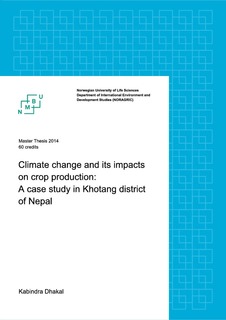| dc.description.abstract | This research was carried out to study climate change and its impacts on major crops production in Khotang district of Nepal. The effect of climate variables on crops yield and farmers` respond to climate change in the last eight to ten years were studied and analyzed. Monthly precipitation data in Aiselukharka, Kuruleghat, Khotangbajar and Diktel; and monthly minimum and maximum air temperatures data in Okhaldhunga, Chainpur East and Udayapur Gadhi available from the Department of Hydrology and meteorology in Nepal were used to study their annual and seasonal trends. Time-series annual yield data in maize, paddy, wheat, millet and potato were collected from the District Agriculture Development Office Khotang. The linear trends in various sites were computed to study the climate variations whereas multiple regressions were used to study the relationships between climate variables and crop yields. Focal group discussions, key informants interviews, household survey and field observations were carried out in Bamrang Khola micro-watershed in Khotang district as an empirical survey.
Variations in temperatures and precipitations trends were observed in different sites. There was a tendency towards increased mean air temperature and a tendency towards a decreased yearly precipitation in Khotang district; however, these trends were not significant. Yields have increased for most crops and this is likely to be related with improved management practices, increased use of fertilizers and pesticides. The significant effects of climate variables were observed in maize and wheat yields. The yield of maize has a negative relationship with minimum air temperature and a positive relationship with maximum air temperature whereas the yield of wheat has positive relationships with maximum air temperature and precipitation, and a negative relationship with minimum air temperature.
Farmers’ perceptions in Bamrang Khola micro-watershed revealed that the changes have been observed in frequencies, durations and intensities in monsoon and winter rainfall, fogs, snowfalls and storms. The impacts of these changes have resulted in increased attack of white grub in roots and maize smut in cobs, rice blast in panicle and stem, rust and blight disease and grain borer in wheat, red ants in potato. Farmers adapt to these changes by altering crop management practices as sowing time, sowing methods, weeding practices, varieties and in the methods of irrigation practices. | nb_NO |

